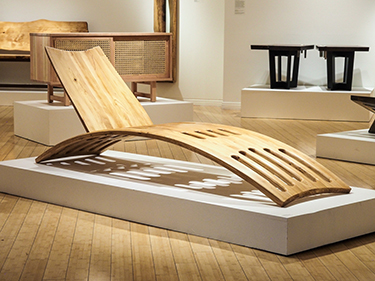|
Subscribe / Renew |
|
|
Contact Us |
|
| ► Subscribe to our Free Weekly Newsletter | |
| home | Welcome, sign in or click here to subscribe. | login |
Architecture & Engineering
| |
August 24, 2016
Thousands of dead trees are windfall for designers of furniture in LA exhibit
Associated Press
LOS ANGELES — Furniture designer Harold Greene grew up making toys out of reclaimed scraps of wood in his Southern California neighborhood.
So when a windstorm pummeled Los Angeles County on Nov. 30, 2011, destroying thousands of trees, he and nine other members of the L.A.- based Box Collective, a group of environmentally conscious furniture makers and designers, did what came naturally. They set about collecting wood from the fallen trees to make furniture and art.
Their efforts, including the 63-year-old Greene’s poolside-perfect, streamlined “Chaise Lounge,” have been gathered in the “Windfall” exhibit at the Craft and Folk Art Museum here. The show, which runs until Sept. 4, features an array of works, from benches and end tables to bowls.
“This exhibit is important because it’s dedicated to sustainable materials and educating the public about what is possible with trees growing in front of their place, in their own front yard,” said Greene, a one-time firefighter who has designed and built furniture full-time since 1979.
When the 2011 windstorm swept through the West, it caused an estimated $34 million in damage, and hit northeastern Los Angeles County especially hard. Uprooted trees and tangled branches crushed homes and cars. The community of Arcadia alone lost roughly 2,000 trees, including hundreds at its Los Angeles County Arboretum and Botanic Garden.
The wood for Greene’s “Chaise Lounge” — a beige cedar that he cut into thin strips, which he laminated and layered on a curved form — came from trees destroyed at the arboretum.
“This storm was a literal windfall of material for us if we could find a way to capture it before it was thrown away, which is the fate of most, if not all, of the wood from the urban forest,” said furniture designer Cliff Spencer, 43, who recently moved from Los Angeles back to Birmingham, Alabama, where he grew up doing woodwork.
Using paulownia wood from the arboretum, Spencer created three pieces for the exhibit, including a beehive.
His “Sound Diffuser for a Noisy City” consists of small pieces of wood and boxes layered into a large, square sound-diffusion board, covered with colorful doodles. His “Red Yellow Blue Wood” panel is a medley of geometric shapes.
“You’re making use of a resource that was otherwise overlooked ... so it feels good not to just create more waste,” said Spencer.
For beginners wanting to make furniture out of sustainable wood, both Spencer and Greene suggested working with someone who is already doing it. Greene recommended finding a community college class taught by furniture makers, and local wood at woodworking stores.
If there’s a fallen tree you want to use, you have to mill it. Milling is the process of cutting wood into thicknesses of different dimensions, making it easier to work with.
And you can’t rush it. The wood has to dry one year for every inch of thickness that you cut, Greene said. Once it’s dry, test the moisture level. Wood that isn’t dry enough will shrink and move after you make something with it.
Furniture designer RH Lee, 38, who teaches woodworking and design at California State University, Long Beach, said her students work with slabs milled in previous years.
Her dark brown “End Tables” with San Francisco-based collaborator JD Sassaman, which incorporates paulownia wood from the Arboretum as well as black walnut and claro walnut, have a unique twist: granite spires pounded into the wood.
The tables were inspired by a backpacking trip the pair took through the Sierra Nevada mountains, through snowy granite peaks, wind-damaged trees and the Devils Postpile National Monument.
“The story that a fallen tree tells is much more interesting and varied than the industrially harvested and milled boards you have access to at a lumber yard,” Lee said.
Designer Casey Dzierlenga created her round “Lorca Coffee Table” from a maple tree that fell in her friend’s backyard. One part of the table looks like it was bitten into, revealing the tree’s natural grain and shape.
For designer and Box Collective co-founder Robert Apodaca, 38, who now lives in Philadelphia, the story behind his three “Blackout Bowls” is very personal. When the 2011 storm downed a huge eucalyptus tree on the off-ramp of a freeway near his former Los Angeles home, he waited until city workers cut it into smaller pieces. Then he pulled his truck up to the freeway shoulder and loaded up.
After waiting for the wood to dry, he milled it and hand-scraped it, then used a blowtorch to give the sides a blackened finish.
“You’re turning something that would have gone into a landfill into something beautiful,” he said.



